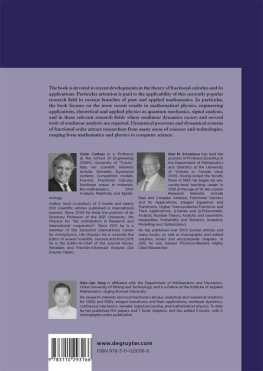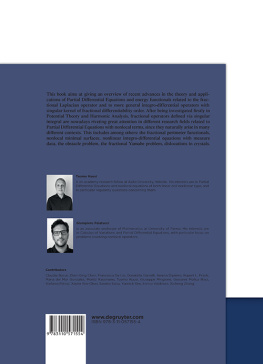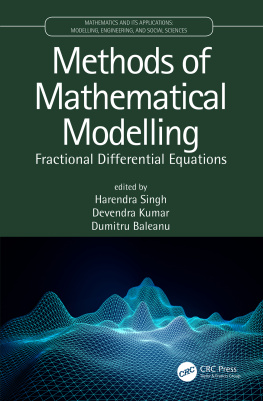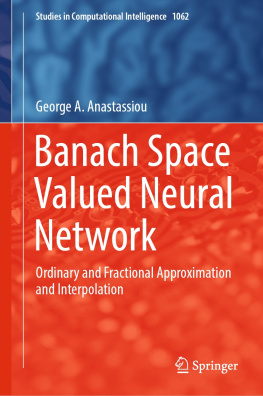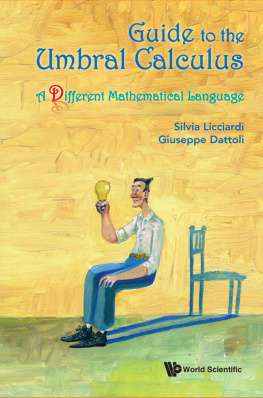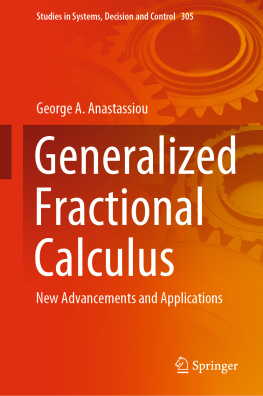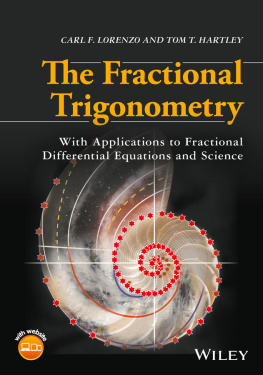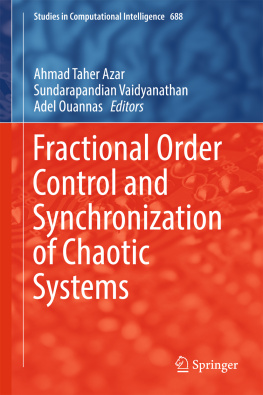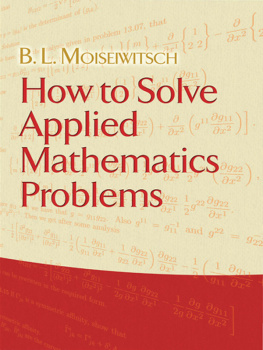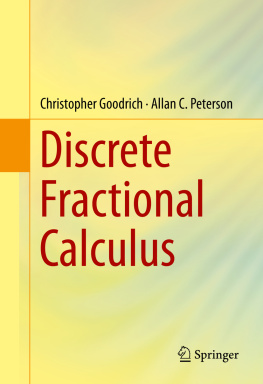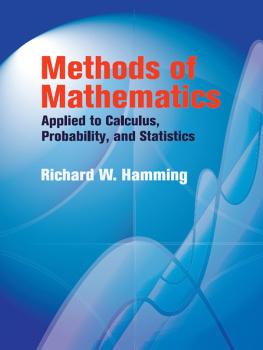Carlo Cattani - Fractional Dynamics
Here you can read online Carlo Cattani - Fractional Dynamics full text of the book (entire story) in english for free. Download pdf and epub, get meaning, cover and reviews about this ebook. City: Warsaw, year: 2016, publisher: De Gruyter, genre: Science. Description of the work, (preface) as well as reviews are available. Best literature library LitArk.com created for fans of good reading and offers a wide selection of genres:
Romance novel
Science fiction
Adventure
Detective
Science
History
Home and family
Prose
Art
Politics
Computer
Non-fiction
Religion
Business
Children
Humor
Choose a favorite category and find really read worthwhile books. Enjoy immersion in the world of imagination, feel the emotions of the characters or learn something new for yourself, make an fascinating discovery.
- Book:Fractional Dynamics
- Author:
- Publisher:De Gruyter
- Genre:
- Year:2016
- City:Warsaw
- Rating:3 / 5
- Favourites:Add to favourites
- Your mark:
- 60
- 1
- 2
- 3
- 4
- 5
Fractional Dynamics: summary, description and annotation
We offer to read an annotation, description, summary or preface (depends on what the author of the book "Fractional Dynamics" wrote himself). If you haven't found the necessary information about the book — write in the comments, we will try to find it.
Fractional Dynamics — read online for free the complete book (whole text) full work
Below is the text of the book, divided by pages. System saving the place of the last page read, allows you to conveniently read the book "Fractional Dynamics" online for free, without having to search again every time where you left off. Put a bookmark, and you can go to the page where you finished reading at any time.
Font size:
Interval:
Bookmark:

Fractional Dynamics
(Eds.)
Dynamics

Published by De Gruyter Open Ltd, Warsaw/Berlin
Part of Walter de Gruyter GmbH, Berlin/Munich/Boston

This work is licensed under the Creative Commons Attribution-NonCommercial-NoDerivs 3.0 license, which means that the text may be used for non-commercial purposes, provided credit is given to the author. For details go to http://creativecommons.org/licenses/by-nc-nd/3.0/.
2015 Carlo Cattani, Hari M. Srivastava, Xiao-Jun Yang and chapters contributors, published by de Gruyter Open
ISBN 978-3-11-029316-6
e-ISBN 978-3-11-029319-7
Bibliographic information published by the Deutsche Nationalbibliothek
The Deutsche Nationalbibliothek lists this publication in the Deutsche Nationalbibliografie; detailed bibliographic data are available in the Internet at http://dnb.dnb.de.
Managing Editor: Agnieszka Bednarczyk-Drg
Language Editor: Nick Rogers
www.degruyteropen.com
Cover illustration: Thinkstock/3quarks
This volume is devoted to recent developments in the theory of fractional calculus and its applications. Particular attention is paid to the applicability of this currently popular research field in various branches of pure and applied mathematics. In particular, we have focused on the more recent results in mathematical physics, engineering applications, theoretical and applied physics as quantum mechanics, signal analysis, and in those relevant research fields where nonlinear dynamics occurs and several tools of nonlinear analysis are required. Dynamical processes and dynamical systems of fractional order attract researchers from many areas of sciences and technologies, ranging from mathematics and physics to computer science.
Fractional calculus is an intriguing mathematical theory which dates back to the very foundation of differential calculus when Leibniz (1695) raised some concern about derivatives of fractional order. However, it was Liouville (1832), and nearly contemporarily to him, Riemann (1847) and Fourier (1822), who collected into an independent theory all the basic knowledge about fractional order derivatives and fractional order integrals. Since then and especially in the last century, there has been an increasing interest on fractional calculus and its application in many different fields in Mathematics, Physics, Engineering, Bio-Science, Computer Science, Economics and so on.
In order to explain why fractional calculus is attracting more and more scholars with different scientific and cultural background is due to the following reasons:
1.Although it is almost completely clear what does it mean by fractional derivative and fractional integral and which basic axioms should be taken to define these operators, fractional derivative as operator doesnt fulfill all properties of the ordinary derivative. For this reason, in order to circumvent this problem many additional axioms were assumed, so that, as a consequence, there are different definitions of the same operator, which give rise to different, sometimes competing, fractional derivatives. All definitions are mathematically respectful, but the main problem is that up to now there is not a unique definition of fractional derivative.
2.Since their origins, fractional derivatives were linked to the fractional calculus. There is always a debate on local (for the derivative) and non-local (for derivative) approach to fractional-order operator calculus. For the nonlocal fractional calculus, some boundary conditions are needed and this implies global approach to such problems.
3.The fundamental operators of fractional calculus are based on special functions which, in turn, are strongly depending on efficient computational methods and numerical algorithms. Therefore, the modern advancements on computational and numerical methods have pushed the recent development of fractional calculus and the massive interests of the scientific community.
However, as a consequence of these main concerns, we have reached a situation where there are still some unsolved theoretical problems in fractional calculus whereas there are many different fractional models in applications. In fact, any physical, engineering, and mathematical problems that are being investigated by a fractional calculus might have a variety of fractional models, depending on the local-nonlocal approach and/or on the chosen fractional derivative among the many alternative definitions. Moreover, the many recently developed numerical methods add confusion to the multi-facet fractional models. In fact, different choices of orthogonal functions and bases would lead to different fractional models.
Very recently there have also been several successful attempts to extend local fractional calculus to non differentiable, irregular sets like fractals. The possibility to extend the fractional calculus to self-similar unsmooth objects is opening new frontiers in science, such as, for example, in signal analysis, data sets from complex phenomena, image analysis, nuclear medicine, and so on. Nonlinear analysis of data, collected by modern devices, offer still unsolved analytical problems related not only to complex physics and abstract mathematical theories, but also to nonlinear science. From analytical point of view, these kinds of problems are often leading us to deal with the concepts of scales, fractals, fractional operators, and so on.
In this volume, we have collected some of the main contributions to the fields of local and non-local fractional calculus, aiming to explore the most recent advancement in several branches of science and technology.
This volume consists of a total of 22 chapters which are outlined below.
(by C. Cattani) deals with the fractional calculus applied to Shannon wavelet theory. This chapter introduces a novel definition of local fractional derivative which makes it possible to compute the derivative of any finite energy function, that is, of a localized function which can be represented by wavelet series.
In , V. E. Tarasov studies three-dimensional discrete dynamical systems with long-range properties and gives some applications for different types of dynamical systems.
In , Antnio M. Lopes and J.A. Tenreiro Machado investigate the statistical distributions of earthquakes in Southern California over the time period from the year 1934 up to the year 2013. The reported results reveal relationships and temporal patterns hidden in the data. Also, the investigated methodology and findings can contribute to a comprehensive explanation of these phenomena and to recognize precursory events for earthquake prediction.
(by Akira Asada) deals with an integral transform arising from fractional calculus, which is used for investigating the solution of some differential equations.
In , Jordan Hristov fully shows how to obtain approximate solutions to time-fractional models by integral balance approach. This long chapter completely describes the theory of integral balance approach for finding approximate solution of fractional differential equations.
(by Bashir Ahmad, Ahmed Alsaedi and Hana Al-Hutami) presents a study of sequential fractional q- integro-difference equations with perturbed anti-periodic boundary conditions.
Font size:
Interval:
Bookmark:
Similar books «Fractional Dynamics»
Look at similar books to Fractional Dynamics. We have selected literature similar in name and meaning in the hope of providing readers with more options to find new, interesting, not yet read works.
Discussion, reviews of the book Fractional Dynamics and just readers' own opinions. Leave your comments, write what you think about the work, its meaning or the main characters. Specify what exactly you liked and what you didn't like, and why you think so.

